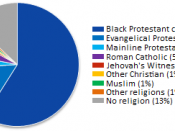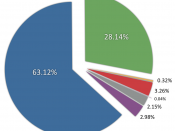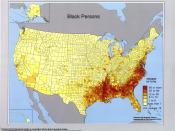January 19, 2010The cultural diversity of Abilene Texas is unique to many cities. In my city we have an Air Force base that brings many different cultures together because of the service men and women. Over this course I have learned how many different cultures coexist in America. America is a melting pot of cultures and within each culture there are several different beliefs, religions, and traditions. I will explore the ethnic diversity of my city, with my research I have found that Abilene Texas has a little bit of every culture represented.
The ethnic population of Abilene Texas is majority White with Latino following in second. We have a wide variety with almost every ethnic population being represented by a number. The white population isÃÂ82.4 %ÃÂ( Census Bureau, p.1) this makes up the majority of the ethnic population in my city. The second largest ethnic population in my city is White person not Hispanic with ÃÂ47.4
%ÃÂ( Census Bureau, p.1), there is also a strong Latino representation with ÃÂ36.5 %ÃÂ( Census Bureau, p.1) following with African American ÃÂ11.9 %ÃÂ( Census Bureau, p.1). Those are the three main ethnic cultures in Abilene with the following Asian Decent ÃÂ3.5 %ÃÂ( Census Bureau, p.1), American Indian or Alaskan Native ÃÂ(0.8 %ÃÂ( Census Bureau, p.1), and last Native Hawaiian or Pacific Islander with ÃÂ0.1%.ÃÂ(Census Bureau, p.1) I found these records to be the most recent figures for ethnic population in Abilene Texas from the Census Bureau of 2008. I feel we have a strong Mexican American representation due to we live close to the Mexican border. The other reason we have a strong mix of cultures is due to the military base in our city.
I do not feel that each ethnic group is equally represented in my community, the majority is White Americans. Following with White person not Hispanic, I do not quite understand what this ethnic group is? Abilene is close to the Mexican border so we do have quite a large Mexican American ethnic representation in my city. The balance of equal ethnic groups is becoming equal in my city over time. When you look back to the 2000 census bureau statistics you will find that the Whit population was ÃÂ78.1 %ÃÂ( Census Bureau, p.1), and the Hispanic or Latino origin were ÃÂ19.4%.ÃÂ(Census Bureau, p.1) This ethnic gap has been closing fast in the last 8 years. In the future I feel my city will see a more equal representation of ethnic groups.
When looking for the most common form of ethnic discrimination in my city I could not find any statistics that stuck out as the most common. Instead I found several reports of sexual, age, religious and ethnic discrimination cases in the local news papers. What I did find interesting is a complaint and lawsuit against our city council for not representing the minorities on the city council board. ÃÂOne Black and two Mexican-Americans have been elected to the council since 1973ÃÂ( Velasquez v. City of Abilene Texas, p.1) This case was over African Americans and Mexican Americans not having equal representation on the city council board. The minority members on the board have been a token slot for these ethnic groups, these positions have been nominated by Citizens for Better Government. ÃÂThe record shows that no independent Black or Mexican-American has ever been elected, although several have run unsuccessfully.ÃÂ(Velasquez v. City of Abilene Texas, p.1) Though these people are on the board their vote does not compete with the majority, so their vote does not really count on issues that the other members do not feel strongly about. The trial ended with the lack of evidence that council members have been deliberately keeping minorities out of the council elections.
My cities local justice department does not discriminate against ethnic groups. The statistics that I could find were for only juvenile offenders but I feel that this should not be different from adult offenders. Our juvenile arrest rate for male was ÃÂ66.8 %ÃÂ( Police Statistics, p.1) and the female arrest rate is ÃÂ33.2 %ÃÂ( Police Statistics, p.1) these statistics are for 2008 as 2009 statistics are still being tallied. Juvenile race arrest records are as follows, ÃÂAfrican American 33.5%, Hispanic 39.6%, and White 33.5 %ÃÂ( Police Statistics, p.1) Looking at these statistics I do not feel that one ethnic race is discriminated against more than another. With these numbers I feel safe to say that in Abilene Texas our police department does not profile ethnic minorities.
The largest welfare recipients in my community are deceiving of the statistics that I have found. In percentages I found that ÃÂWhite 10.8%, African American 23.1%, Hispanic 21.8%, American Indian 21.3 %, Asian 16.2%, and Native Hawaiian or Pacific Islander 15.9%.ÃÂ(Poverty Rate Data, p.1) In absolute numbers the data is different for the poverty rate in Abilene, ÃÂWhite 7,801, African American 2,304, Hispanic 6,240, American Indian 305, Asian 763, and Native Hawaiian or Pacific Islander is 0.ÃÂ(Poverty Rate Data) When a person looks at these two graphs on poverty the first graph will say that there are more African Americans and Hispanics that are in poverty compared to Whites. But when you compare the numbers to each race you can clearly see that there are more White people in poverty. The difference in these graphs is represented on the amount of people in each ethnic group. When you take the number of poverty people against the total number of people in an ethnic group you receive a percentage. I feel that in total there are more White people in my city so therefore more White people are in poverty. These figures are for 2007 and with the recent recession hits the country has taken I feel these statistics are out dated and do not compare to the new figures.
The graduation rate for high school students in Abilene is very good I think across the board. ÃÂWhite 57%, African American 10%, Hispanic 31%, Asian 1%ÃÂ(Public School Review, p.1) Overall Abilene has a high school graduation success of 81 % overall. I feel this is a good number, but as always there is room for improvement. With this research and statistics I found that not one minority ethnic group was left behind is school more than another.
The United Way helps out my community in a slightly different way than most other communities. Abilene Texas was selected to help refuges transfer into American society. This a unique coarse that offers refugees a new chance on life in a different country. In Abilene they are taught English and receive their General Education Degree. Along with the United Way we have Dyess Air Force Base located in Abilene also, our men and women of the Air Force donate some of their time to many activities to our younger people. Many service men and women I found like to work with the big brothers, big sisters and the BoyÃÂs and GirlsÃÂ club of Abilene. When I was talking to the office manager on the phone she was very help full in explaining all the different areas the unite way helps out our community. Their budget is spent mostly on youth programs and family programs. Many of these programs involve the YMCA, Noah Project, and the Salvation Army. The Salvation Army helps out families needs from clothing, shelter, school supplies, and food. The Salvation Army welcomes all donations and since there are many hunters in the locale area they will accept meat donations from wild game. These donations of wild game must be processed from an approved locker and come in the original packaging.
What I have learned from this course is about how each ethnic group is different in many ways and on we should all be judged on what is in our heart and not by the color of our skin. While doing research on my home city for my finale project I was surprised to find some of the figures and statistics. Since I do not have any kids and work long hours I do not go out on the town much, I like to hang out with friends when I have some down time. With Dyess Air Force Base located on our city limits this brings in a broad spectrum of different ethnic groups. I did not feel that this town had or has discrimination towards any particular cultures. At my work I work with Mexican Americans, African Americans, Whites, and Puerto Ricans. We all get along and many times have cook outs during high wind days at work. Many people who I thought would have been Latino or Mexican descent do not even come from those cultures; they turn out to be Cuban or South American. We as people cannot keep grouping people together into just a couple of categories. We need to understand their beliefs, religion, and embrace their culture. Until we walk a mile in another personÃÂs shoes we cannot judge them. I have learned about tolerance and other cultures from this course and will continue to look at other ethnic cultures for more understanding. Besides you never know when other culture may have a better idea than we do.
ReferencesCensus Bureau for Abilene Texas, 2006 Retrieved January 18, 2010 from http://quickfacts.census.gov/qfd/states/48000.htmlUnited Way of Abilene Texas, Retrieved January 18, 2010 from http://unitedway-abilene.org/about/United States Court of Appeals, Fifth Circuit ÃÂVelasquez v. City of Abilene Texas,ÃÂ March 2, 1984, retrieved January 18, 2010 from http://openjurist.org/725/f2d/1017Police Department of Abilene Texas Statistics, 2007-2008, Retrieved January 18, 2010 from http://www.abilenepolice.org/statistics.htmAbilene, Texas (TX) Poverty Rate Data, ÃÂInformation about poor and low income residentsÃÂ 2007, Retrieved January, 18, 2010 from http://www.city-data.com/poverty/poverty-Abilene-Texas.htmlPublic School Review ÃÂAbilene High SchoolÃÂ January, 9 2010 Retrieved January 18, 2010 from http://www.publicschoolreview.com/school_ov/school_id/75519





